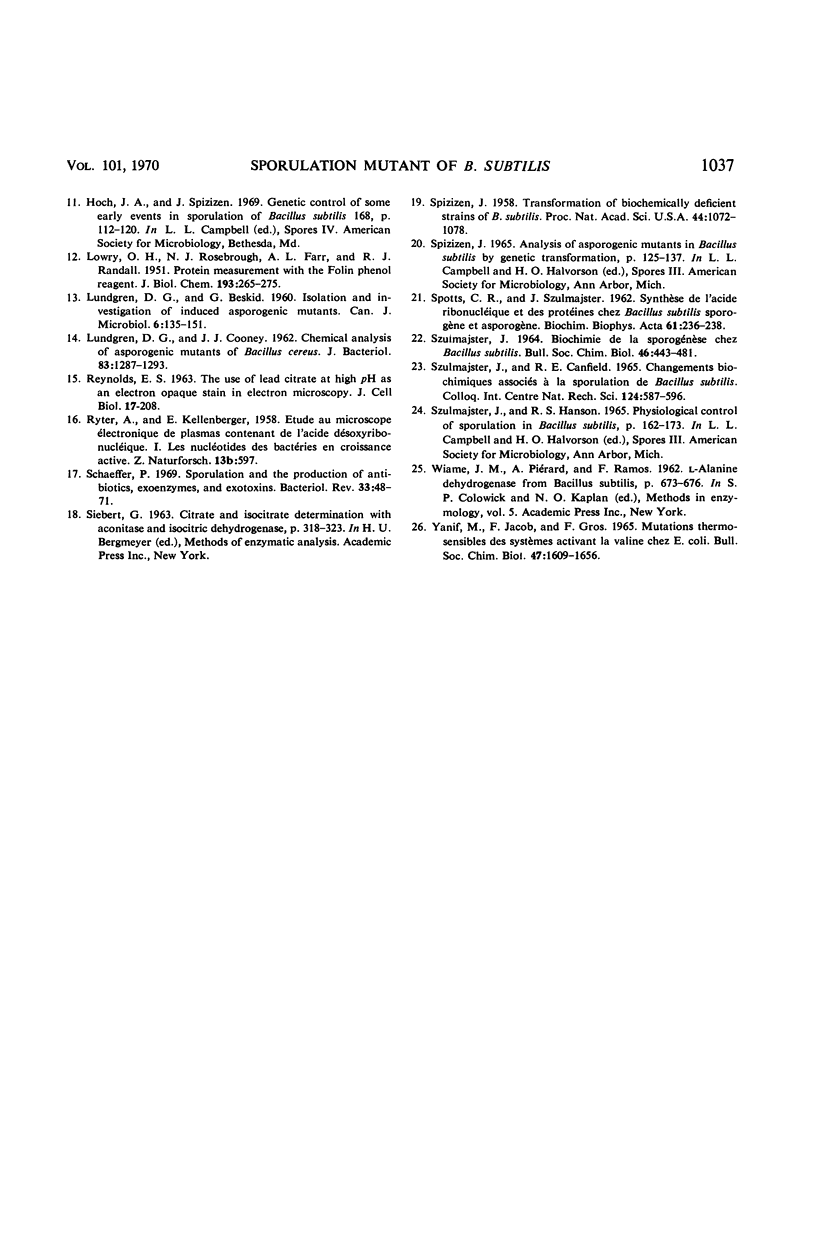Abstract
A thermosensitive sporulation mutant (ts-4) of Bacillus subtilis was isolated, and its morphological, physiological, and enzymatic properties were investigated. This mutant is able to grow equally well at 30 and 42 C, but is unable to sporulate at the higher temperature. Electron microscope studies have shown that the ts-4 mutant is blocked at stage zero of spore development. This was further confirmed by its inability to produce antibiotic when grown at the restrictive temperature and by the relatively low ribonucleic acid (RNA) and protein turnover during the stationary growth phase, characteristic for stage zero asporogenic mutants. At the permissive temperature, however, antibiotic production and RNA and protein turnover took place at the rate normally found in sporogenic strains of B. subtilis. The above properties were not altered in the parent strain when grown at either 30 or 42 C. By shifting cultures of the ts-4 mutant from 30 to 42 C and from 42 to 30 C at different stages of growth, we have been further able to show that the event affected at the high temperature takes place at a very early stage of spore development. As a consequence of this early block in the sporulation process, the ts-4 mutant grown at 42 C became defective in the late spore-specific enzymes involved in the biosynthesis of dipicolinic acid. This study suggests that the sporulation process is mediated by a regulatory protein which is altered in the thermosensitive mutant when grown at the restrictive temperature. As a result of this alteration, a pleiotropic phenotype is produced which has lost the ability to catalyze the late biochemical reactions required for spore formation.
Full text
PDF










Images in this article
Selected References
These references are in PubMed. This may not be the complete list of references from this article.
- BLACK S., WRIGHT N. G. Aspartic beta-semialdehyde dehydrogenase and aspartic beta-semialdehyde. J Biol Chem. 1955 Mar;213(1):39–50. [PubMed] [Google Scholar]
- Bach M. L., Gilvarg C. Biosynthesis of dipicolinic acid in sporulating Bacillus megaterium. J Biol Chem. 1966 Oct 10;241(19):4563–4564. [PubMed] [Google Scholar]
- Balassa G. Biochemical genetics of bacterial sporulation. I. Unidirectional pleiotropic interactions among genes controlling sporulation in Bacillus subtilis. Mol Gen Genet. 1969;104(1):73–103. [PubMed] [Google Scholar]
- Chasin L. A., Szulmajster J. Biosynthesis of dipicolinic acid in Bacillus subtilis. Biochem Biophys Res Commun. 1967 Dec 15;29(5):648–654. doi: 10.1016/0006-291x(67)90265-3. [DOI] [PubMed] [Google Scholar]
- DONNELLAN J. E., Jr, NAGS E. H., LEVINSON H. S. CHEMICALLY DEFINED, SYNTHETIC MEDIA FOR SPORULATION AND FOR GERMINATION AND GROWTH OF BACILLUS SUBTILIS. J Bacteriol. 1964 Feb;87:332–336. doi: 10.1128/jb.87.2.332-336.1964. [DOI] [PMC free article] [PubMed] [Google Scholar]
- Freese E., Fortnagel P. Analysis of sporulation mutants. I. Response of uracil incorporation to carbon sources, and other mutant properties. J Bacteriol. 1967 Dec;94(6):1957–1969. doi: 10.1128/jb.94.6.1957-1969.1967. [DOI] [PMC free article] [PubMed] [Google Scholar]
- LOWRY O. H., ROSEBROUGH N. J., FARR A. L., RANDALL R. J. Protein measurement with the Folin phenol reagent. J Biol Chem. 1951 Nov;193(1):265–275. [PubMed] [Google Scholar]
- LUNDGREN D. G., COONEY J. J. Chemical analyses of asporogenic mutants of Bacillus cereus. J Bacteriol. 1962 Jun;83:1287–1293. doi: 10.1128/jb.83.6.1287-1293.1962. [DOI] [PMC free article] [PubMed] [Google Scholar]
- REYNOLDS E. S. The use of lead citrate at high pH as an electron-opaque stain in electron microscopy. J Cell Biol. 1963 Apr;17:208–212. doi: 10.1083/jcb.17.1.208. [DOI] [PMC free article] [PubMed] [Google Scholar]
- RYTER A., KELLENBERGER E., BIRCHANDERSEN A., MAALOE O. Etude au microscope électronique de plasmas contenant de l'acide désoxyribonucliéique. I. Les nucléoides des bactéries en croissance active. Z Naturforsch B. 1958 Sep;13B(9):597–605. [PubMed] [Google Scholar]
- SZULMAJSTER J. BIOCHIMIE DE LA SPOROG'EN'ESE CHEZ B. SUBTILIS. Bull Soc Chim Biol (Paris) 1964;46:443–481. [PubMed] [Google Scholar]
- Schaeffer P. Sporulation and the production of antibiotics, exoenzymes, and exotonins. Bacteriol Rev. 1969 Mar;33(1):48–71. doi: 10.1128/br.33.1.48-71.1969. [DOI] [PMC free article] [PubMed] [Google Scholar]
- Spizizen J. TRANSFORMATION OF BIOCHEMICALLY DEFICIENT STRAINS OF BACILLUS SUBTILIS BY DEOXYRIBONUCLEATE. Proc Natl Acad Sci U S A. 1958 Oct 15;44(10):1072–1078. doi: 10.1073/pnas.44.10.1072. [DOI] [PMC free article] [PubMed] [Google Scholar]
- Yaniv M., Jacob F., Gros F. Mutations thermosensibles des systèmes activant la valine chez E. coli. Bull Soc Chim Biol (Paris) 1965;47(8):1609–1626. [PubMed] [Google Scholar]




